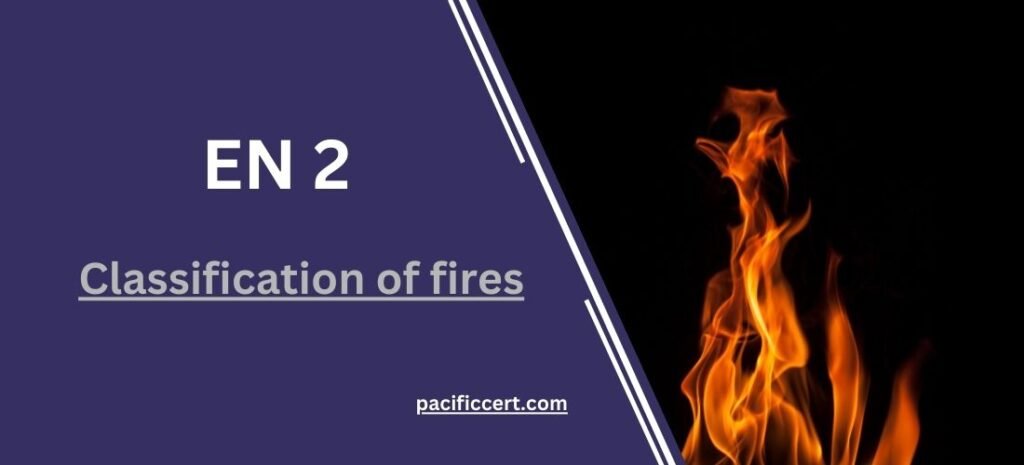
What is EN 2: Classification of fires?
EN 2 is a European Standard, it provides a classification system for fires based on their source and the type of fuel that is burning. This standard is used to help fire protection professionals and other stakeholders understand the nature of a fire and determine the appropriate methods for extinguishing it.
The EN 2 standard defines five classes of fire, each of which is identified by a letter:
Class A: Fires involving solid materials. Such as wood, paper, or textiles.
Class B: Fires involving flammable liquids or liquefiable solids. Such as petrol, diesel, or grease.
Also, Class C: Fires involving gases. Such as propane, butane, or natural gas.
Class D: Fires involving metals. Such as magnesium, aluminum, or sodium.
Class F: Fires involving cooking oils and fats.
Each class of fire has unique characteristics that determine the most effective methods for extinguishing it. For example, water may be effective for extinguishing Class A fires, but it can be dangerous to use water on Class B fires involving flammable liquids.
The standard also includes information on the appropriate types of fire extinguishers and other fire-fighting equipment for each class of fire. This can help fire protection professionals and other stakeholders select and use the most appropriate equipment for a given fire situation.
EN 2 standard provides a common language and framework for understanding the different types of fires. And the appropriate methods for extinguishing them.
Requirements of EN 2
Definitions and terminology: EN 2 provides definitions and terminology for the different classes of fire, which helps to ensure that there is a common understanding of the classification system.
Classification criteria: The standard provides criteria for classifying fires based on their fuel source. And the type of material that is burning.
Classification symbols: Each class of fire is identified by a symbol, which is used to indicate the appropriate types of fire extinguishers and other fire-fighting equipment that should be used.
Testing methods: EN 2 specifies testing methods for determining the classification of fires, which helps to ensure that the system is reliable and consistent.
Guidance on fire extinguishers and other fire-fighting equipment: This standard provides guidance on the appropriate types of fire extinguishers and other fire-fighting equipment that should be used for each class of fire. This includes information on the types of extinguishing agents that are effective for each class of fire and the appropriate methods for using them.
Benefits of EN 2: Classification of fires
Common language: EN 2 provides a common language and framework for classifying fires based on their fuel source. Also, the appropriate methods for extinguishing them. This helps to ensure that fire protection professionals and other stakeholders have a consistent understanding of the different types of fires. And the most effective methods for dealing with them.
Improved safety: The classification system provided by this standard can help improve safety. By ensuring that the appropriate types of fire extinguishers and other fire-fighting equipment are used for each class of fire. This can help to prevent injuries and minimize damage in the event of a fire.
Consistency: EN 2 provides criteria for classifying fires based on their fuel source and the type of material that is burning. Thus, This helps to ensure that the system is reliable and consistent, which can improve safety and reduce the risk of errors or misunderstandings.
Testing methods: The standard specifies testing methods for determining the classification of fires. This helps to ensure that the system is based on sound scientific principles. And that the results are consistent and reliable.
Regulatory compliance: Compliance with EN 2 is mandatory for fire protection equipment and systems sold in the European Union. Compliance with this standard can help manufacturers and distributors ensure that their products are safe, effective, and meet regulatory requirements.
EN 2 standard provides a common language and framework for classifying fires and selecting the appropriate fire-fighting equipment. Therefore, Compliance with this standard can help improve safety, and reduce the risk of errors. Also, ensure regulatory compliance.
Who needs EN 2: Classification of fires?
Firefighters: EN 2 provides firefighters with a clear understanding of the different types of fires and the appropriate extinguishing methods to use for each type.
Building owners and managers: Understanding the classification of fires can help building owners and managers implement appropriate fire safety measures. Such as selecting the correct type of fire extinguisher for different areas of a building.
Fire safety professionals: This standard is an important reference for fire safety professionals who are responsible for developing fire safety plans, conducting fire risk assessments. And ensuring compliance with fire safety regulations.
Manufacturers and suppliers of fire extinguishers: EN 2 is used as a basis for the design and testing of fire extinguishers, so manufacturers and suppliers need to be familiar with its requirements. To ensure that their products are safe and effective.
Also, Insurance companies: Insurance companies use EN 2 as a basis for assessing fire risks and determining appropriate insurance premiums.
Pacific Certifications is accredited by ABIS, if you need more support with EN 2, please contact us at +91-8595603096 or support@pacificcert.com
Read About: EN 1: FLUED OIL STOVES









